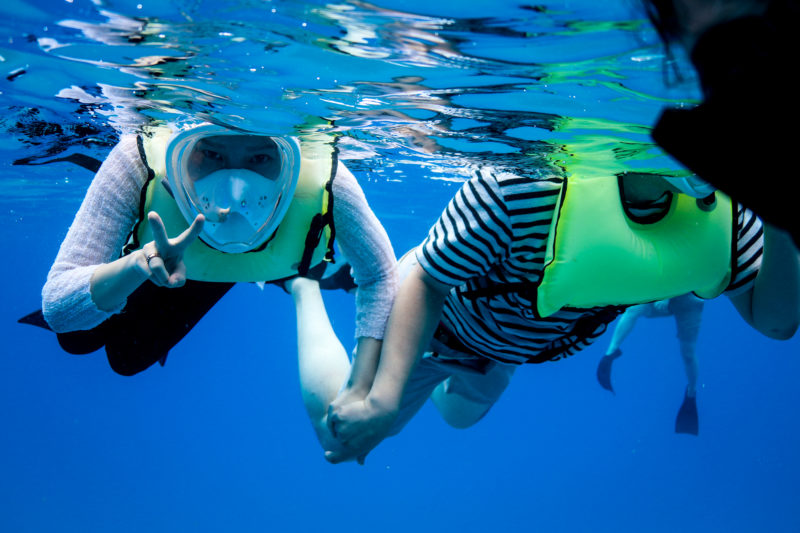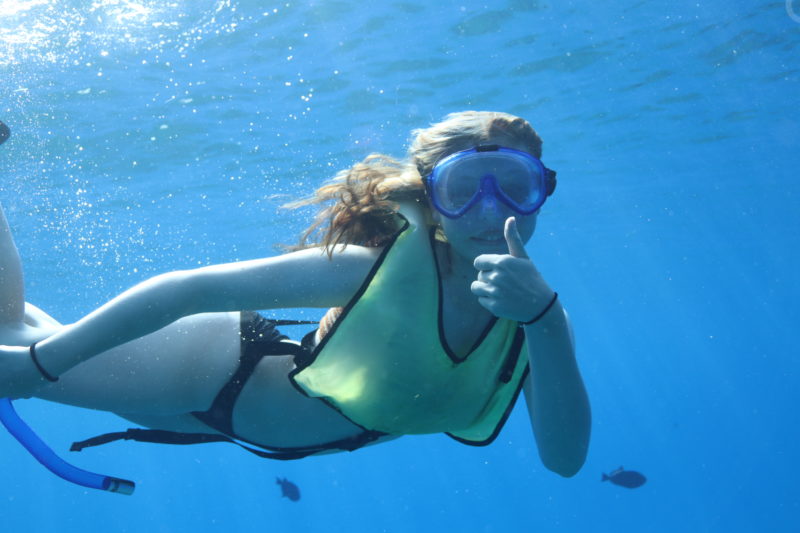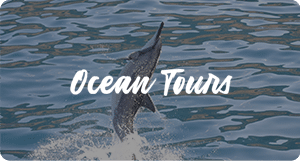The Potential Dangers of Full-Face Snorkel Masks
At And You Creations/Dolphins and You, safety is our top priority. That’s why we’ve made the decision to ban full-face snorkel masks on our tours due to growing concerns about their safety. Instead, we provide all participants with high-quality, traditional snorkeling equipment to ensure a safe and enjoyable experience in Hawaii’s waters.
Why Are Full-Face Snorkel Masks Risky?
Full-face snorkel masks have grown in popularity for their convenience and wider field of vision. However, these masks, originally designed for calm, surface-level snorkeling, have been linked to an increase in accidents, particularly in the dynamic and unpredictable ocean environment.
Key Risks of Full-Face Masks:
- Difficulty Removing in Emergencies: Full-face masks fit tightly around the head, making them hard to remove in a state of panic.
- Water Infiltration: If water leaks inside, it’s nearly impossible to clear it without removing the entire mask.
- CO2 Buildup: Poorly designed masks can allow carbon dioxide to accumulate, potentially causing dizziness, headaches, or even unconsciousness.
- Variable Quality: High-end full-face masks are designed to separate airflow, but cheaper knock-offs lack these safety features, increasing the risk for users.
While research is ongoing, many snorkeling tour operators in Hawaii, including And You Creations/Dolphins and You, have taken a precautionary approach by banning full-face snorkel masks to prioritize guest safety.

Safety Concerns in Hawaii
In Hawaii, several accidents and tragic incidents have been linked to full-face snorkel masks. The issue gained attention in 2016 when a frequent visitor tragically drowned while using one for the first time off the Big Island. Following this, Hawaii lawmakers began investigating the potential hazards of the equipment.
Reports from 2018 revealed that nearly half of snorkeling-related drownings in Hawaii occurred while using full-face masks. With the lack of federal regulations for snorkel gear, the risks remain, prompting local tour operators to err on the side of caution.
We encourage the use of traditional snorkel gear for a safer and more reliable underwater experience. On both our Oahu snorkeling activities, Dolphins and You and Turtles and You, we provide high-quality traditional snorkeling gear for all our guests.
Making the Switch: Traditional Snorkel Gear
For first-time snorkelers, traditional snorkels might take some getting used to, but they’re a safer and highly effective option. On our tours, we provide high-quality silicone masks and snorkels designed for comfort and ease of use.
Tips for Comfortable Snorkeling:
- Prevent Fogging: Apply a little defog solution or baby shampoo to the inside of your mask.
- Proper Fit: Push hair away from your face to ensure a tight seal, but avoid over-tightening the mask.
- Snorkel Placement: Practice shaping your mouth by saying “ah,” “ee,” and “ooh” to get a good fit.
- Clearing Water: If water enters the snorkel, exhale strongly (saying “TWO”) to clear it, or remove it and shake out the water.
- Stay Calm: Breathe slowly and evenly. If you feel uneasy, stop swimming, remove the snorkel, and float while calming your breathing.
Our experienced guides are always on hand to help you feel comfortable and confident in the water, whether it’s your first time snorkeling or your hundredth!

Accidents in Hawaii
Full-face snorkel masks have been linked to several accidents in Hawaii, prompting many Snorkeling tour operators in Hawaii to ban their use. Concerns about these masks gained widespread attention in 2016 when a frequent visitor tragically drowned while using one for the first time off the Big Island. Her husband, Guy Cooper, urged state officials to investigate the role of snorkeling gear in such incidents.
By 2018, reports revealed that nearly half of snorkeling-related drownings in Hawaii involved full-face masks. In addition to fatalities, there have been several near-misses, including rescues in Oahu and Kauai in 2019. With no federal regulations for snorkel gear, many operators have chosen to prioritize guest safety by prohibiting these masks on their tours.
A Safer, More Enjoyable Experience with And You Creations/Dolphins and You!
We provide all guests with safe, high-quality snorkeling gear to explore Oahu’s marine life with peace of mind. Our professional team ensures your adventure is both safe and unforgettable.
Ready to dive into an incredible snorkeling experience? Book your spot on our Oahu snorkeling adventure today, and let us guide you to the wonders of Hawaii’s underwater world—safely and comfortably.












